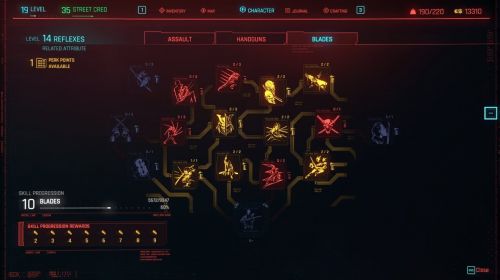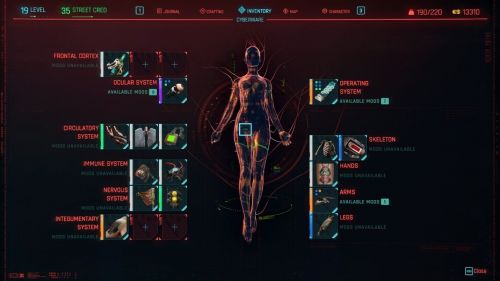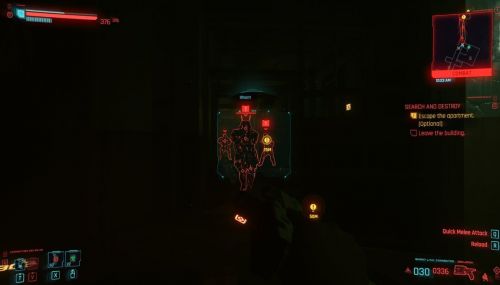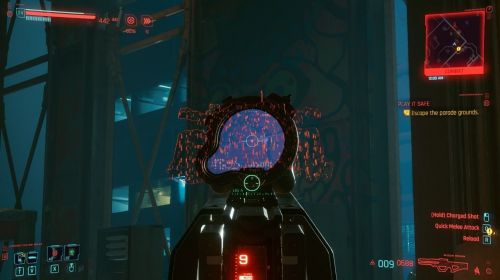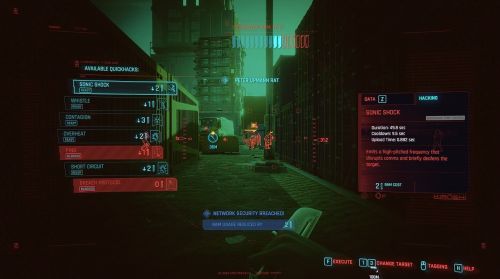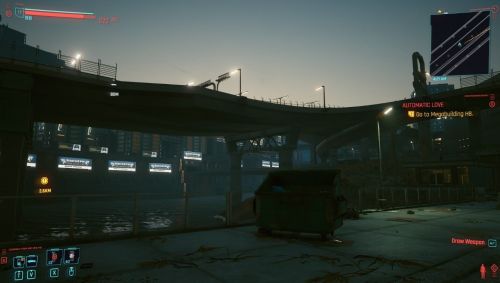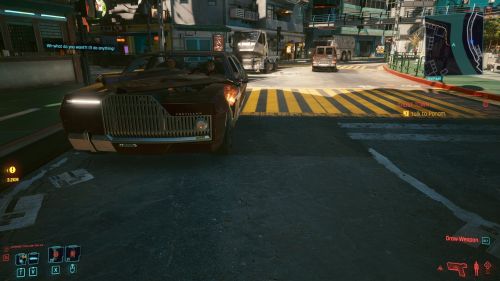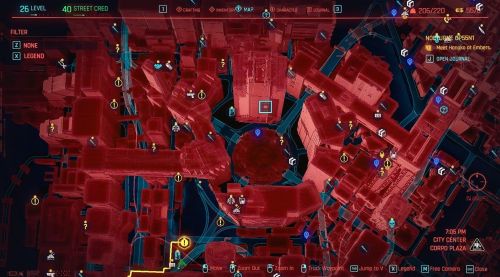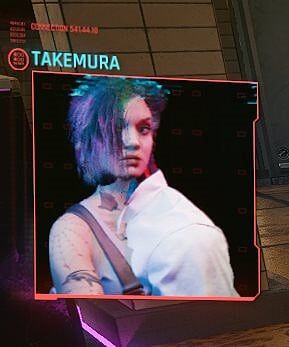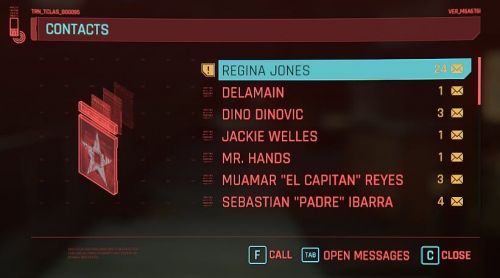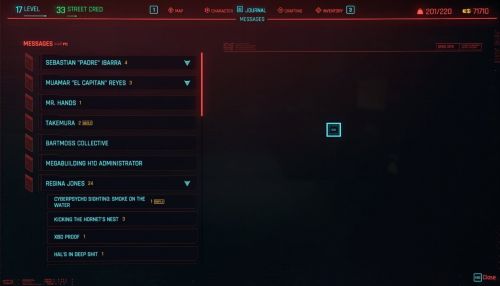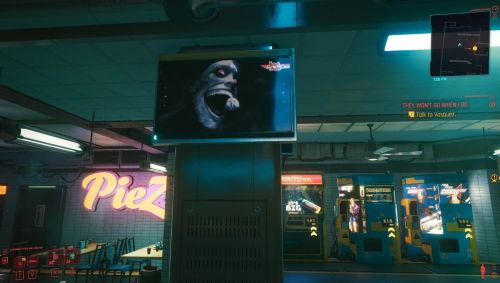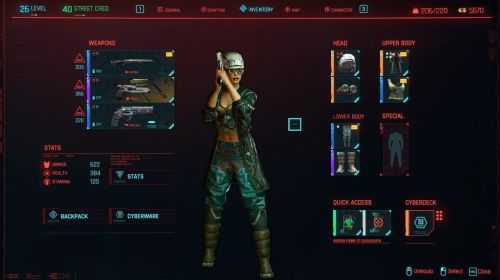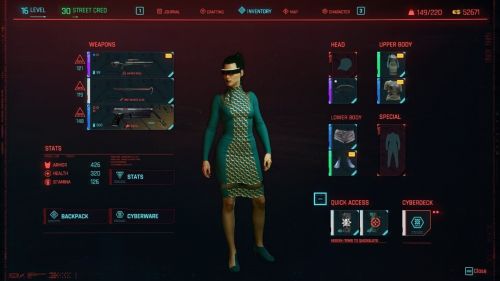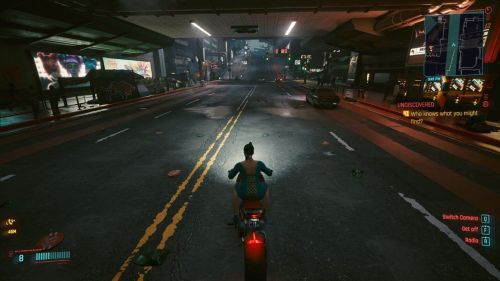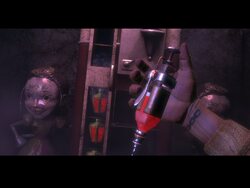RPG Codex Review: Cyberpunk 2077
RPG Codex Review: Cyberpunk 2077
Codex Review - posted by Infinitron on Tue 19 January 2021, 18:31:08
Tags: CD Projekt; Cyberpunk 2077By the usual standards, CD Projekt's latest mega-AAA hit Cyberpunk 2077 should have been considered a huge success. It reviewed well enough on PC and managed to recoup its entire development cost via pre-orders alone. However, the game's console ports were a disaster, and in a year when we all had enough too much free time on our hands, it was enough to generate a massive negative publicity firestorm for the company, including class action lawsuits and an investigation by the Polish government. Several days ago CD Projekt published a video with CEO Marcin Iwinski apologizing for the poor state of the game, and a few days later it scored a comparatively pathetic seventh place in our all-important Codex GOTY poll. Now would be the perfect time to publish our own official review of Cyberpunk 2077, and thanks to a surprise contribution from esteemed user lukaszek, we actually managed to pull that off. It's a thorough examination of the game, including character building, combat, open world elements, quest design and itemization. Here's an excerpt from the review:
Read the full article: RPG Codex Review: Cyberpunk 2077
You might wow an NPC in dialogue with your tech knowledge. All it will accomplish is the NPC not coming up with the same solution in the next sentence. In most cases it doesn’t matter what you say, as the outcome will be the same. The quest design formula is usually as follows (main story quests included):
On rare occasions the game will surprise you. Instead of following the quest marker on autopilot, there might be hidden objectives for you to unlock if you step off the marked path.
The start of the game is like Dragon Age: Origins. You get 3 origins that all forcefully converge into one path – one of the street kid. Without spoiling too much, you’ll get a choice at the end of the main storyline that mirrors each lifepath, but has nothing to do with your original choice. It’s all about flavor and some unique responses that, as I stated, usually don’t matter. The corp path is quite sad as you’re a suit for a few minutes, but the rest of the game has nothing to do with it. In that prelude, you’ll be forced to play a weakling vomiting from stress in the bathroom, while corp lines are usually about strong-handling NPCs to make them do what you want. Nomads and Street Kids can sort of continue their life. The corp origin also gets the weakest extra quest compared to the other two (although you do get the best tech pistol in the game).
Endings are not like in The Witcher where you have to live with your choices. You get a special save point, and after you end the game, you return to that save with a unique item based on the choice you’d made during the last quest. You can rinse and repeat to experience and obtain everything. A few endings are locked behind certain characters liking you, meaning completing their optional quest chains and not annoying them during dialogues. This is the only lasting consequence to your actions that I’ve found.
For example, consider blasting a powerplant during the main story – all you’ll see is a news flash during the loading screen or while waiting in an elevator. Side quests don’t get even such mentions.
- You speak with a fixer. It’s either a recorded video message or a long dialog. If you get a chance to speak, there’ll be many options to pick, but nothing will matter, as you’ll get your objectives anyway.
- You follow the quest compass and there might be a locked door. If it’s locked, you might be able to unlock it. If you can’t – go jump out of the nearest window. Do it at full speed and without checking what’s behind. You will land safely on a balcony and will clearly see how to jump or climb to another open window. Sometimes it will be a ladder in the back of the building, but you get the idea.
- There will be enemies. Kill them silently, go blasting, sneak past them – it doesn’t matter.
- Approach the objective. There might be an optional pacifist option here, but that’s rare.
- Escape the area.
- Get a phone call.
On rare occasions the game will surprise you. Instead of following the quest marker on autopilot, there might be hidden objectives for you to unlock if you step off the marked path.
The start of the game is like Dragon Age: Origins. You get 3 origins that all forcefully converge into one path – one of the street kid. Without spoiling too much, you’ll get a choice at the end of the main storyline that mirrors each lifepath, but has nothing to do with your original choice. It’s all about flavor and some unique responses that, as I stated, usually don’t matter. The corp path is quite sad as you’re a suit for a few minutes, but the rest of the game has nothing to do with it. In that prelude, you’ll be forced to play a weakling vomiting from stress in the bathroom, while corp lines are usually about strong-handling NPCs to make them do what you want. Nomads and Street Kids can sort of continue their life. The corp origin also gets the weakest extra quest compared to the other two (although you do get the best tech pistol in the game).
Endings are not like in The Witcher where you have to live with your choices. You get a special save point, and after you end the game, you return to that save with a unique item based on the choice you’d made during the last quest. You can rinse and repeat to experience and obtain everything. A few endings are locked behind certain characters liking you, meaning completing their optional quest chains and not annoying them during dialogues. This is the only lasting consequence to your actions that I’ve found.
For example, consider blasting a powerplant during the main story – all you’ll see is a news flash during the loading screen or while waiting in an elevator. Side quests don’t get even such mentions.
Read the full article: RPG Codex Review: Cyberpunk 2077
[Review by lukaszek, edited by Darth Roxor]
It’s anyone’s guess how long Cyberpunk 2077 was in development. Based on Marcin Iwiński’s remarks about a “mysterious team working on a brand new AAA game,” it would be about 9 years. Over that time, it became the most anticipated title in the video game world. It was also postponed three times, which made other developers gnash their teeth, since nobody wanted to risk an overlapping release. The CD Projekt marketing team sure has done a spectacular job, and we are bound to see some articles or papers on their brilliant strategy in the coming future. The fact that CP2077 is the most pre-ordered title up to date, with 8 million copies confirmed by CDPR, is a testimony to that.
Now consider that all of this is true even though the studio shared very limited information about the game, which also happens to be something that CDPR is infamous for. Then there's the joke of an old gen console version, the review copies distributed at the very last moment, the 60+ GB day zero patch… The issues were and are numerous. Sometimes it’s hard to tell what’s a bug and what’s a feature. What the game will look like after a year of patching is anyone’s guess. Me, I played on a PC bought around the time The Witcher 3 came out, and I was able to play on medium settings smoothly and without crashes.
But ignoring all that, is it a good game? While the writing team didn’t drop the ball, I can’t say the same about the gameplay and numerous design choices that I’m about to dissect. There are many complex systems working together in CP2077, so it’s going to be quite a read.
If CDPR was in such a rush for cash flow, they should have stuck to what worked for them in the past. Yes, I mean Gorasul, which they released on Polish ground in 2002, and which remains the high water mark in their company history ever since their founding in 1994. However, it’s currently not available for digital purchase, so make sure to have your voice heard in here https://af.gog.com/wishlist/games/gorasul_the_legacy_of_the_dragon?as=1649904300
The character system
There are 6 attributes, with one that is cut/hidden/awaiting DLC. Each covers 2-3 skill trees that are unique to it. The maximum level of both attributes and skills is 20. Attributes and perks need to be assigned manually, and you get 1 attribute point during level-ups along with a single perk point. This is the only source of attributes, while you’ll be getting plenty of perk points in other ways. Depending on how much yougrind explore – you will finish the game around level 20-30. This means that you’ll be able to max a single attribute out of the 6 available ones. Skills level up through use, but they can’t exceed their governing attributes. Increasing skills unlocks boring boosts like +3% katana swing speed and extra perks. You can reset spent perk points via money, but that is not true for attribute points, which makes the whole reset idea rather useless. To illustrate this with an example: it will allow you to switch from katanas to revolvers, as both are covered by Reflexes, but you won’t be able to respec into shotguns, which are under Body.
The attributes are:
That’s it for the theory. The skill trees are numerous, but you can complete the entire game without spending a single perk point in them. Weapons don’t have requirements (though some firearms require 6 Body or you will suffer larger recoil). You can use everything as you please. I’ve already mentioned that skill improvements are minuscule, but most perks aren’t much better. Most are boring, like 3-10% damage increases (depending on the weapon), but there are others that give actual damage multipliers, and more unique ones, like a perk that unlocks a knife throw action.
It appears that perks were planned a longer while back and they were never revisited. 30% of the stealth tree consists of trap choices. It supports knife throwing, which is quite the chore to execute. Someone had this great idea to make it impossible to retrieve the knives you throw. Meanwhile, they are expensive, as crafting them isn’t cheap, and you roughly need to spend the equivalent of a single quest reward in money on a single knife. You must also manually enter the inventory to equip a replacement for the one you’ve thrown. There are also “cool” perks centered around stealthy takedowns and being undetectable while underwater. In this game, you’re encouraged to just shoot enemies’ heads with a suppressor rather than creep in and choke them. Not only is it easier and yields more skill XP, but the game also doesn’t really acknowledge pacifist mission completion. There are no consequences to your actions, so you can just kill everyone instead of putting them to sleep. As for swimming, I’ve completed the main storyline and only then did I realize that I’ve spent that perk point for stealthy swimming while never getting close to any water! I had to find some water to confirm that indeed – swimming is implemented.
If I were to point out the most interesting attributes, those would be Tech Ability and Cool. Those two also allow you to invest into every combat playstyle at once.
Crafting in Tech is quite boring, and you are fine skipping it entirely even if you invest in the attribute. It does allow you to improve iconic (unique) items, and if you find something that you like, then you’d definitely want to improve it fully. What I like the most here is the boost to TECH weapons, which I’ll discuss in later sections. It’s definitely the coolest, best and worst game mechanic at the same time. The upgrades found under this attribute are meaningful and can work with any TECH firearm.
COOL’s boring side is the stealth tree. If you like creeping around, you will find some quality of life improvements here. Even if you don’t, you may still want this attribute because of the Cold Blood skill tree. This is like berserk mode that works with any weapon. You will be faster, sturdier, regenerate more health and deal more damage provided you keep killing enemies quickly.
If you want to complete everything, it would mean opening every door in this game. Attribute checks are extremely rare, and they don’t lead to anything interesting, save for that one 10+ INT check in one of the side quests, which actually unlocks a cool result that does matter. Most doors/windows/vents are covered by strength (brute force) and technology (lockpicking). Some extra information gathering might require Intelligence. On rare occasions, you can use INT to bypass password protection on terminals. Worry not though, the devs wouldn’t want to lock you out of anything of importance. Everything that is to be found includes only containers with random items, though a few unique weapons are hidden like this too. One of my playthroughs had me putting points in int/body/tech, so I got to open everything, and I gained nothing of importance. In the end, it will boil down to how many combat-free entries will be available in the building in front of you. Don’t worry, there’s always at least one.
It’s weird that character building is so detached from cyberware. It would make sense to have them be more intertwined, like in Shadowrun Hong Kong.
Cyberware without barriers
There is no cost other than money when it comes to slotting chrome into your body, and even that can be nullified as there are pieces to be found out in the world. What’s more, most of the pieces have no attribute requirements or they appear to be mismatched. Head slots usually require INT, while BODY is the attribute for chest slots. Otherwise it can be quite varied. With no attribute investment, you should still be able to fill nearly all of the slots in your body, sometimes even with cyberware of the highest rarity.
Take the cyberdeck for example – most surprisingly it requires no INT. You can acquire one of the best cyberdecks in the game while still being in act 1 (before Johnny Silverhand tags along). Epic level hacks can be grabbed from vendors. You will be able to become quite the competent netrunner without any adjustments to your build.
Similar thing with mantis blades – you can find legendary ones right at the beginning of act 2 and start shredding enemies as you please. You see, contrary to items, cyberware has no level requirements. I recommend mantis blades to those who want to have a combat experience in this game but without needing to deal with itemization. Meanwhile hacking would be the EZ mode for those who don’t even want to see combat.
Speaking of cyberarms, there was some serious cutting of the content shown in pre-release videos. Gorilla arms do not help in opening doors. Mantis blades won’t enable wall running. Monowire doesn’t allow hacking at range (you can hack everything you can see anyway). Monowire is in a rather sorry state right now. You can obtain its legendary version at the start of act 1 for free, and never use it again once you realize how underperforming it is. Its damage is based on the Cool attribute, while it levels the unarmed skill (under Body) and is boosted by unarmed perks. Also, contrary to the non-updated description, monowire doesn’t help with stealthy takedowns. That one might be related to the sorry state of takedowns in the game in general. It appears that at one point they aimed for level complexity similar to Styx, but that was lost along the way. What’s also interesting – having any kind of cyberarms doesn’t seem to allow you to simply punch enemies.
There is a bit of redundancy between perks, cyberware and item mods. Chrome is the biggest money sink (unless you are interested in vehicles, I guess), and you should just slot everything you can. Bonuses range from boring ones like extra damage/attack speed to unique double jump and time slowing abilities. Some item mods/cyberware also overlap with perks – examples include immunity to shock or aiming while dodging.
Combat
Before I get into the FPS experience, let’s discuss firearms. There are 2 categories of guns to be had:
Smart weapons have auto-targeting, which again requires the relevant cyberware. If you like shooting but can’t aim, or you play with a controller, then this might be for you. Damage tends to be unremarkable, but I’ll admit that unloading a smart shotgun and watching all the pellets land true can be fun. It first targets the chest and then switches to the head after some delay. Add the double jump cyberware to the mix, and you can now relive your Titanfall experience (minus the wall running).
Tech is the unique weapon type. While these can be fired like every other gun, they don’t have auto mode, as holding the trigger begins a charging process that gradually increases the damage. When the maximum charge is reached – the weapon fires automatically. Depending on your BODY, aiming while charging can be quite challenging. Some weapons can fire in a unique mode at full charge, like going auto, discharging multiple projectiles, and some fire maximum charge shots without even charging. All tech weapons at max charge fire through any number of obstacles between you and your target. Dipping into the tech tree increases damage rapidly and eventually disables the automatic discharge. Since every tech weapon can behave differently, exploring them is pretty fun.
With that prelude, now is the time to discuss the FPS aspect of CP2077. From early vids, it was clear that Cyberpunk would be joining the ranks of shooter RPGs. So how does the shooting feel? On a scale of Fallout 3 to Fallout 4, it’s definitely closer to former. The comparison is surely justified, given Bethesda’s janky shooting mechanics, which were further solidified by the bending of bullet trajectories to help the player hit the mark. Meanwhile, the next game in the series delivered a proper FPS experience and was fairly enjoyable as that (rather than as an RPG).
When playing online shooters, what is the number one most popular hack? It’s wallhack, of course. In CP2077 there are multiple ways to enable seeing your enemies through walls. You can use the ping quickhack (which requires no investment) to highlight all the enemies (and explosives while you are at it). Using sixth sense you can mark enemies while they are visible, so that they can never hide from you. There’s even an eye cyberware enhancement that just marks all the enemies that are aware of your position. If that was not enough, certain firearms have a special property – if you aim at an obstacle that has an enemy behind it, his contour will be made visible.
And it’s not just any weapon type – the superiority of Tech reveals itself again! With energy weapons you can both see and shoot enemies through walls. Headshots are easy to execute this way – all you have to do is charge a bit, although some unique variants don’t need to be charged at all. But to clarify, this doesn’t mean that walls can be destroyed. In fact, most of the obstacles are indestructible.
You can clear an entire building without even entering it. Mind you, enemies can shoot through the walls too. Even worse, due to bugs you can never be sure whether it’s tech weapons that you’re up against, or just collision issues.
As such, especially on higher difficulties, shooting from behind cover might not be the best idea. Since enemy aim appears to worsen when you move, you will be discouraged from camping.
There are also time slowing measures you may know from other games. Here, they’re accessible through fairly cheap cyberware.
Throw in some bugs, and combat can be a frustrating experience indeed. For example: an enemy is shooting you through the wall. Is it a problem with the collision system? Or maybe he is using one of the tech weapons that allow it. If that’s the case, then why is the laser pointer from his gun beaming through the column, and why can’t you find the tech weapon on his corpse afterwards?
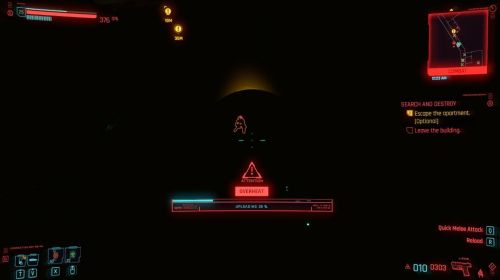
A netrunner hacking me through two floors, while I’m about to make a few holes in him through obstacles. Might be the single best picture showing how annoying combat can get. No cameras were in sight to enable such hacking behavior.
Melee
I never enjoy first person stealth and melee, and this game is no exception. I wonder if a third person perspective might be added at a later point – after all, code from The Witcher must still be buried here somewhere, and it’s already supported by vehicle mechanics.
The third person view brings some level of body awareness. In the first person you don’t know your katana range nor the exact jump length when you navigate the battlefield. Knowing if you can jump or vault over an obstacle can be quite crucial, as otherwise you’ll need to pull yourself up, which will let the enemies unload their weapons at you with ease. As such, the jump cyberware upgrade is very important for melee characters.
If I were to attach difficulty ratings to playstyles, melee would definitely be the hardest one. Being forced out of cover in combat will make you plan your moves in the early game, so you’d better enjoy stealth. There is no blocking or slashing enemyarrows bullets. One has to wonder even more what happened to The Witcher code – I played that game with the keyboard and mouse and never complained. Meanwhile CP2077 doesn’t appear to keep PCs in mind anymore. Instead of hitting alt+movement to dodge gracefully, someone had the bright idea to introduce double key strokes, and so the dash ability is gated behind double tapping movement. Changing the double tap key binding isn’t supported so far, but there are workarounds if you’re willing to manually edit the game files. The dodging that I’m describing here also tackles NPCs. Before you adapt to the controls, you will start a few fights with NPCs this way. Also, it puts you out of stealth, so you will have to reload a few times. In short, you won’t be able to dash in between enemies to avoid bullets on the PC. It may be slightly off topic here, but key bindings are a broader problem in general. For example, crouching and skipping dialog share the same key. Given the NPCs’ habit to call you at the wrong time, expect to break out of stealth on occasion.
Worry not though, combat is relatively easy even on the hardest difficulty (play that one or you won’t face enemy netrunners at all), and you’ll quickly become overpowered regardless of your playstyle. Melee just happens to pick up steam at the slowest rate. There is a payoff though – health gain on hits/kills is an ability mainly associated with melee. Eventually you will become nearly indestructible carnage incarnate. Mantis blades will help as they offer a unique leap ability that lets you close the gap faster. The main problem in melee is accidentally hitting explosive objects and blowing yourself to pieces.
Binary wizardry
Since I described the hardest way to mow down enemies, it’s time to describe the easiest. Now imagine it’s not about shooting heads through obstacles with a wallhack. Let’s talk binary wizardry.
You can hack anyone and anything that you can see. But this won’t apply anymore during the late game, once you unlock the highest grade of the ping wallhack. When you do that – you’ll be able to hack enemies through obstacles too. Once you trigger sixth sense, time slows down and you can start hacking the environment and enemies. Optionally, you might want to start a logic minigame called Breach. If you hate it, it’s fine to skip it. It offers cost discounts for quickhacks as well as area debuffs, if you’ve unlocked them in the Breach skill tree.
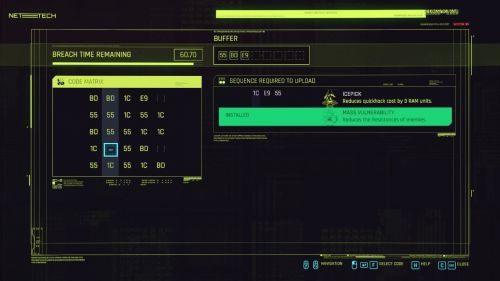
Breach minigame: switch columns & rows to reach one of the sequences to the right. Rewards include credits, reduced quickhack costs, debuffs or, on rare occasions, new spells quickhacks.
You can now proceed to pick quickhacks to be applied to each entity.
Hackable objects in the environment range from TVs and mines to cameras and turrets. You can force them to malfunction, which makes nearby enemies investigate (this helps with stealth), turn them off or take them over. Taking control of cameras allows you to apply quickhacks via proxy, from a new angle. Taking over a turret usually means game over for enemies in the area as they tend to pack serious firepower. All of this is accessible without putting points into INT or upgrading your cyberdeck. Once you do get better cyberware, you can force turrets to be friendly, although in my experience they lack accuracy. For some reason, if you hijack a turret, this seems to reveal your position to every enemy and makes them focus on you – the netrunner – instead of the turret, which is the immediate danger in front of them. If you disable all the cameras in stealth, they will turn back on when combat starts. This is true even if there is no netrunner around or a tech guy alive by an access point. Very annoying.
Hacking both the environment and enemies is doable just fine with no investment. The main limiting factor is the cyberdeck you pack.
To affect humans and robots, you’ll need to have quickhacks memorized in your cyberdeck. The number of slots depends on the deck’s quality alone. You will be able to slot about half of the available quickhacks at most, although you are free to swap them mid-combat. Hacks improve with their rarity. Initially, they will either inconvenience your enemies, with effects like reduced accuracy, or apply raw damage. Eventually they gain the ability to spread and remove combatants on the spot.
By mid-game you will be emptying your entirespellbook cyberdeck with your spell points ram depleting and refilling without issues. To cite a classic, it’ll be like watching a Dragon Ball fight from Krillin’s perspective.
And the best part? It’s silent. Enemies won’t know your position. They won’t investigate when their ally suddenly bursts into flames.
There is no casting time or channeling. Each hack has a specific delay before it’s applied and a cooldown to recast. You can dump all the quickhacks available to you at the same time in an instant, and this is what you will be doing. Cast them all, watch the hacks upload to enemies in the area, watch them kill and spread around, repeat. Yes, since hacking is like a free action, you’re free to either sit and wait or mix it with another playstyle, like blasting with a shotgun.
You’ll be fine laying waste with upgraded simple hacks, without resorting to fancy ones that make enemies commit suicide.
Overall there are a lot of options available to you, yet all of this will quickly become intuitive. If anything, the battlefield is overcrowded with possibilities and your mind will filter them out – why drop boxes at a patrolling enemy when a silenced headshot will do the trick just as well? Yet despite all of this, the combat can be fun, though not in the way intended by the devs. The Witcher offered enemy variety through the bestiary, and you had to prepare oils and tactics. Here, at best, you check what type of weapon a given human is using and then dispose of him from the appropriate range. The lack of difficulty as the game progresses plays a role as well. Over time the combat becomes simple, mindless and quite relaxing, actually. It’s like blowing off some steam while playing Serious Sam, except here the game gives you tools to tailor your play style and modify the way you dispose of the hordes of enemies.
If I were to compare – playing a stealth archer was more fun in Skyrim than in CP2077. Technically this game is more complex, but the enemy AI is even worse.
GTA where walking is better than driving
Vehicles are the weakest part of the game by far, and quests that force you behind the wheel are the most annoying.
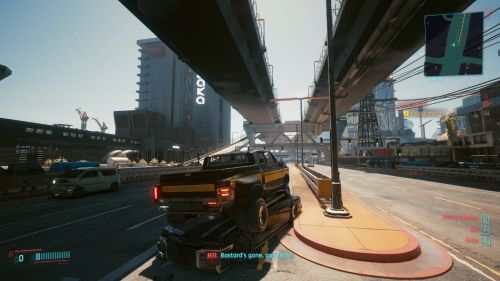
Here’s a highlight of a quest involving a car chase, with cars appearing out of nowhere, and getting stuck on top of one of them.
If you have a choice, grab a bike. Bikes are actually quite sturdy and you can ram cars head-on with them in some cases.
If I were to describe how the driving feels, the cars behave as if they had their center of gravity on the upper part of the vehicle while weighing 1 kg. Most obstacles are made of paper and you’ll find yourself sliding as if on a slippery surface while attempting to make any turn. There is also no auto centering on the lane, which is something used in GTA or… for the horse in The Witcher 3!
To make it worse, the game tries to cheat traffic. There will be phantom cars within a distance of one block away that will disappear as you approach closer. At the same time, actual cars will appear out of nowhere. I found it the easiest to drive on the opposite side of the road as there was minimal chance of a car spawning there. Meanwhile vehicles will constantly appear out of nowhere from side roads, ramming into you. Fake cars are not turned off even in the Mad Max-esque wasteland outside of the city. You will see heavy traffic ahead of you, which dissappears as you get close, and it’s quite bizarre.
I guess the devs were happy with the Roach-calling memes from TW3 and so never bothered to fix the code. Add some verticality to your game, and this will happen pretty often:
You’ll own a few vehicles without spending money, which is useful, as at times you’ll be calling them all, hoping that at least one will spawn in a reachable place. Sometimes the vehicles you call will also drive past you into the unknown.
To make driving worse, the minimap with a gps doesn’t zoom out as you gain speed. You’ll learn that you’re supposed to turn just as you’re driving past the turn that you’re supposed to take.
You’ll be mowing through pedestrians a lot too, so better hope there’s no police in sight. If they are around, though, most of the time it’ll be better to just reload.
Which I guess takes me to the next point of the GTA comparison – police chases are not fun. Since driving is such a chore, you might think it’s better to approach the policemen on foot and just start blasting. In that case better get ready for police officers to teleport all around you, evenually with red skulls showing up and ending the limited fun you might have had. Police encounters are only part of the “open world” experience, so you won’t be bothered by them during missions… which is strange and sad at the same time. One has to wonder if they weren’t cut, since they’re just not fun. To reiterate: unless you start blasting civilians, you’ll never see police officers during missions.
Speaking of red skulls, they are still there and they are worse than what you remember from The Witcher 3. Instead of having some rare or unique harpy nest in the middle of nowhere and marking it in your memory for a later visit – here you’re dealing with entire districts. In each district, all the missions will feature red skulls as well. Finishing one won’t be rewarding either as XP appears to be a percentage of your level-up bar instead of hard numbers, while the items they might drop will be locked behind level requirements. It’s quite the exploration killer, since it’s easy to complete the game around levels 20-25 and still have large parts of the map locked out this way. The only indicator you get is a quest/map marker difficulty rating ranging from easy to medium and all the way up to very high. If it’s very high, then you’ll see red skulls and you might expect to encounter bullet sponges just like in The Witcher. Except it’ll be a whole crowd of them, and not just a single monster.
You see, it’s not just the character development that doesn’t matter…
Choices don’t matter too as there are no consequences
You might wow an NPC in dialogue with your tech knowledge. All it will accomplish is the NPC not coming up with the same solution in the next sentence. In most cases it doesn’t matter what you say, as the outcome will be the same. The quest design formula is usually as follows (main story quests included):
On rare occasions the game will surprise you. Instead of following the quest marker on autopilot, there might be hidden objectives for you to unlock if you step off the marked path.
The start of the game is like Dragon Age: Origins. You get 3 origins that all forcefully converge into one path – one of the street kid. Without spoiling too much, you’ll get a choice at the end of the main storyline that mirrors each lifepath, but has nothing to do with your original choice. It’s all about flavor and some unique responses that, as I stated, usually don’t matter. The corp path is quite sad as you’re a suit for a few minutes, but the rest of the game has nothing to do with it. In that prelude, you’ll be forced to play a weakling vomiting from stress in the bathroom, while corp lines are usually about strong-handling NPCs to make them do what you want. Nomads and Street Kids can sort of continue their life. The corp origin also gets the weakest extra quest compared to the other two (although you do get the best tech pistol in the game).
Endings are not like in The Witcher where you have to live with your choices. You get a special save point, and after you end the game, you return to that save with a unique item based on the choice you’d made during the last quest. You can rinse and repeat to experience and obtain everything. A few endings are locked behind certain characters liking you, meaning completing their optional quest chains and not annoying them during dialogues. This is the only lasting consequence to your actions that I’ve found.
For example, consider blasting a powerplant during the main story – all you’ll see is a news flash during the loading screen or while waiting in an elevator. Side quests don’t get even such mentions.
The open world feels lifeless. CDPR should have probably emulated The Witcher 2 with its enclosed hubs. Don’t get me wrong, I don’t mean that it’s empty. It’s quite packed but every NPC out there exists only to make a crowd, and if the player performs any hostile action, this façade breaks immediately. Standard NPCs never carry weapons, their only response is to either squat or run away. Drivers aren’t much better. If there is any obstacle, they’ll wait for it to be removed. If you park your bike on the street, you’ll stop the traffic and hear honking in the distance. They will NEVER move. Have a look at what happens when you stand in front of a car and throw a grenade under it. The car might be on fire, yet they’re still waiting.
Police won’t get involved unless you have the wanted status. They’ll never get involved even if there are explosions and shootouts in front of them.
As such, do not expect the unique and exciting car chases you know from GTA.
When it comes to reactivity to the player’s actions, in gaming language terms, Cyberpunk appears to be script heavy instead of using algorithms. Missing the triggers to these scripts is business as usual in this game too. Luckily you get an autosave like every minute, so you can just reload if need be.
The story is the only thing holding the entire game together
It’s good. I wonder if there are many people who decided to quit after going through the prologue. Even if you get fed up with what the game has to offer, you’ll still stay and rush through the main storyline. It’s like Total Recall meets Johnny Mnemonic. The writing quality hasn’t dropped since the Witcher series.
Most of the side quests are of high quality too. Lower tier than that are gigs. These feature some story but are so minimalistic that you should skip them, since soon enough you’ll just be strolling through them on autopilot. All the three types are nicely bucketed in your journal. They’ll also be marked on your map, which is a nice QoL improvement. Apart from them, your map will also feature blue markers, which correspond to criminal activity. You can be a good guy and help fight crime to receive some bounty. Some of them are hand placed, some are algorithmic, and none are very memorable.
It’s a good moment to have a look at the map and discuss the quest density:
It’s like at least one quest (yellow markers) per block. Not all of them will be visible from the start. As your street cred improves, more will appear. Nearly all the quests are started by a phone call from a fixer, rarely by a text message. You’ll pick them up automatically. Nearly every quest completion leads to an increase in street cred, meaning that new quests are unlocked, meaning that new phone calls are made. If you approach a gig on the map, you’ll also get a phone call, sometimes a text.
However, you get quest rewards before you’re done talking with NPCs, which is too bad, since someone else will call you mid-sentence and you’ll have to pick up. And you’ll have trouble figuring out who it is that you’re replying to when this happens. Here’s what it looks like when you manage to receive two simultaneous calls:
While you’re walking through the city, you’ll be attacked by phone calls about a gig on every street corner (the feature seems to be turned off while driving). There’s usually nothing interesting in those calls, so you’ll try speeding them up with the “C” key. Half of the time it won’t work, other half it’ll overlap with the regular crouch functionality of this key, possibly breaking you out of stealth. The “F” key for choosing responses overlaps with world interactions. As I said, the key mappings feel like the PC is no longer a focus for CDPR. Meanwhile I played TW3 with k&m just fine.
Look at those yellow markers again. Half of them are cars waiting to be sold. Someone had this bright idea that vehicles for sale should be quests!
Most of the light blue markers are criminal activity, as mentioned before. They serve as a nice time killer whenever you want to go out and test some new perks or toys.
Keanu Reeves will appear in every main and side quest. Usually he’s your inner chad voice while your regular self is a whiney guy/gal. Like the guy who chases all the girls away at the club and stops all the fun in general. One can only wonder why the Silverhand construct didn’t just take over, to let you play as him through the whole game.
Johnny has quite the personality split, as at times he’ll be complaining about your wasting time (main story line), while in other cases he’ll be the one urging you to do weird quests just to amuse him. If your dream is to have a rollercoaster ride with Johnny screaming wooooohoo! then look no further.
Most of the quests involve working with fixers. Not really talking with them, as 99% of the times they’ll be speaking through a video recording. Sometimes that doesn’t happen, but you’ll wish it did…
As usual, the UI in this game makes you lose sanity. You’ll be collecting shards (lore pieces) that are scattered through the world like trash. From time to time you’ll be asked to read one of them.
You’ll have to find them while browsing through a loosely bucketed screen. Scrolling is the only way to do it and nothing is sorted in any sane fashion. The stuff you need is usually in one of the empty string sections at the bottom:
It does get worse though. Often you’ll need to make a phone call. As you can see, all your contacts are there (the list grows as you play) and they’re not even alphabetically sorted. Usually a quest objective will be conveniently pushed to the top like here:
Which is fine if a phone call is what’s expected of you. The game will often force you to send a text message, and calling does not work. Opening the messages screen takes you to all your contacts without pushing the quest-related one to the top. In the picture below, I was very lucky that Regina was close to the top, as usually it’s not the case:
The personality of the fixers is fairly hit and miss. Out of them all, Wakako and Padre were the ones I enjoyed the most and never had enough of them even while doing filler quests on their behalf. You won’t miss them, since both are connected to the main story. In fact, you won’t miss any fixer, as all of them will introduce themselves when you enter their turf.
Though the best part of CP2077 is not its story. It’s the ads that assault your eyes and ears at every step. Welcome to the world where ads are so cool that no one is using AdBlock. Also, you can find P3n1s enlargement spam in nearly every computer you break into. Looks like either the filtering got worse or the humanity of 2077 truly needs it. There are even channels that screen ads all the time.
Ads are also the main source of music you’ll find. Supposedly there are many radio channels, but given how annoying the vehicles are, I missed that part. For all the cyberware you pack, a radio receiver is not one of them. One of the Nicola drink ads features a sick beat, but sadly none of the radio stations play any similar music.
Itemization is worse than in The Witcher
I believe this was the most heavily criticized aspect of TW3. Copying Borderlands was not the way to go. You’ll be loaded with crap after each fight, and your inventory will likely look like this:
So you’ll be constantly checking if there’s anything worth anything and scrap the rest. You’ll be changing your weapon like every other level (iconic ones might last a bit longer). If you wish to hold on to your favorite piece of gear, then you need to invest in crafting. Instead of finding recipes, ingredients and smiths to give you the end game sword – you’ll be constantly scrapping the things you find and upgrading your weapons. If you seek synergy, the Technology attribute also covers tech weapons that can be of any firearm subtype. Crafting also offers ways of making money: just buy the whole stock of mountain dew from a nearby vending machine, scrap all the cans for aluminum, turn it into a tech rifle, sell it with profit, repeat. The recycling dream.
Your inventory will be fairly cluttered. What’s worse, there’s no key to select an entire stack while scrapping/selling. You’ll pretend that the consumables tab does not exist, as selling/scrapping items there is too tedious. There’s also so much clutter out in the world that you’ll be spamming the pick up key as you clear buildings. Luckily, consumables have no weight. But the grenades do, so remember to drop 200 grenades from time to time.
Another reason why Fallout 4 feels better as a shooter: tinkering with your weapon was fun there – here it isn’t. One can only wish for glorious moments like crafting your lightsaber in Kotor2.
If you want to look cool, then forget about it. The game kind of forces you to keep grabbing whatever has the best stats, leaving you with the hobo look. I used to look worse than this but didn’t record those spectacular occasions:
Alternatively, you can stop using the head slot, get proper glasses and have the upper body piece overwrite both the chest and leg pieces – this will leave you with two slots that you can optimize while preserving your look. Do so and you might quit looking like a hobo.
Not like you’ll be looking at yourself anyway. After character creation you can do that only in the inventory screen, while driving a bike or while looking into a mirror. I recommend cranking the mirror graphic settings to max. It won’t cost you anything, since mirrors in this game are not passive. You have to turn them on to briefly experience your face in all its glory. I wasn’t able to acquire most of the cool looking pieces of clothing found on the streets.
Conclusion
All things considered, Cyberpunk 2077 is an awfully mediocre game. It surely doesn’t bring anything new to the table, no cool mechanics to push the genre into a new branch of evolution… regardless of what genre you consider this to be. Everything it offers has already been done elsewhere to some degree and also executed better.
While one can certainly have some mindless, relaxing fun with it, and experience its involving story – I don’t expect many to talk about CP2077 two… five years from now. In that regard, it might share the destiny of Game of Thrones: build up hype and expectations to levels unheard of – only to disappoint so much during the finale that no one wants to talk about it anymore.
It’s anyone’s guess how long Cyberpunk 2077 was in development. Based on Marcin Iwiński’s remarks about a “mysterious team working on a brand new AAA game,” it would be about 9 years. Over that time, it became the most anticipated title in the video game world. It was also postponed three times, which made other developers gnash their teeth, since nobody wanted to risk an overlapping release. The CD Projekt marketing team sure has done a spectacular job, and we are bound to see some articles or papers on their brilliant strategy in the coming future. The fact that CP2077 is the most pre-ordered title up to date, with 8 million copies confirmed by CDPR, is a testimony to that.
Now consider that all of this is true even though the studio shared very limited information about the game, which also happens to be something that CDPR is infamous for. Then there's the joke of an old gen console version, the review copies distributed at the very last moment, the 60+ GB day zero patch… The issues were and are numerous. Sometimes it’s hard to tell what’s a bug and what’s a feature. What the game will look like after a year of patching is anyone’s guess. Me, I played on a PC bought around the time The Witcher 3 came out, and I was able to play on medium settings smoothly and without crashes.
But ignoring all that, is it a good game? While the writing team didn’t drop the ball, I can’t say the same about the gameplay and numerous design choices that I’m about to dissect. There are many complex systems working together in CP2077, so it’s going to be quite a read.
If CDPR was in such a rush for cash flow, they should have stuck to what worked for them in the past. Yes, I mean Gorasul, which they released on Polish ground in 2002, and which remains the high water mark in their company history ever since their founding in 1994. However, it’s currently not available for digital purchase, so make sure to have your voice heard in here https://af.gog.com/wishlist/games/gorasul_the_legacy_of_the_dragon?as=1649904300
The character system
There are 6 attributes, with one that is cut/hidden/awaiting DLC. Each covers 2-3 skill trees that are unique to it. The maximum level of both attributes and skills is 20. Attributes and perks need to be assigned manually, and you get 1 attribute point during level-ups along with a single perk point. This is the only source of attributes, while you’ll be getting plenty of perk points in other ways. Depending on how much you
The attributes are:
- Body: STR+CON. Handles force-opening doors, health & stamina pools, blunt weapons and shotguns/miniguns
- Reflexes: PER+DEX. Only handles weapons: blades, smgs, pistols
- Technical Ability: Crafting + lockpicking + explosions/disarming + tech weapons (one of the more interesting parts)
- Intelligence:
WizardryHacking - Cool: Stealth & berserk
That’s it for the theory. The skill trees are numerous, but you can complete the entire game without spending a single perk point in them. Weapons don’t have requirements (though some firearms require 6 Body or you will suffer larger recoil). You can use everything as you please. I’ve already mentioned that skill improvements are minuscule, but most perks aren’t much better. Most are boring, like 3-10% damage increases (depending on the weapon), but there are others that give actual damage multipliers, and more unique ones, like a perk that unlocks a knife throw action.
It appears that perks were planned a longer while back and they were never revisited. 30% of the stealth tree consists of trap choices. It supports knife throwing, which is quite the chore to execute. Someone had this great idea to make it impossible to retrieve the knives you throw. Meanwhile, they are expensive, as crafting them isn’t cheap, and you roughly need to spend the equivalent of a single quest reward in money on a single knife. You must also manually enter the inventory to equip a replacement for the one you’ve thrown. There are also “cool” perks centered around stealthy takedowns and being undetectable while underwater. In this game, you’re encouraged to just shoot enemies’ heads with a suppressor rather than creep in and choke them. Not only is it easier and yields more skill XP, but the game also doesn’t really acknowledge pacifist mission completion. There are no consequences to your actions, so you can just kill everyone instead of putting them to sleep. As for swimming, I’ve completed the main storyline and only then did I realize that I’ve spent that perk point for stealthy swimming while never getting close to any water! I had to find some water to confirm that indeed – swimming is implemented.
If I were to point out the most interesting attributes, those would be Tech Ability and Cool. Those two also allow you to invest into every combat playstyle at once.
Crafting in Tech is quite boring, and you are fine skipping it entirely even if you invest in the attribute. It does allow you to improve iconic (unique) items, and if you find something that you like, then you’d definitely want to improve it fully. What I like the most here is the boost to TECH weapons, which I’ll discuss in later sections. It’s definitely the coolest, best and worst game mechanic at the same time. The upgrades found under this attribute are meaningful and can work with any TECH firearm.
COOL’s boring side is the stealth tree. If you like creeping around, you will find some quality of life improvements here. Even if you don’t, you may still want this attribute because of the Cold Blood skill tree. This is like berserk mode that works with any weapon. You will be faster, sturdier, regenerate more health and deal more damage provided you keep killing enemies quickly.
If you want to complete everything, it would mean opening every door in this game. Attribute checks are extremely rare, and they don’t lead to anything interesting, save for that one 10+ INT check in one of the side quests, which actually unlocks a cool result that does matter. Most doors/windows/vents are covered by strength (brute force) and technology (lockpicking). Some extra information gathering might require Intelligence. On rare occasions, you can use INT to bypass password protection on terminals. Worry not though, the devs wouldn’t want to lock you out of anything of importance. Everything that is to be found includes only containers with random items, though a few unique weapons are hidden like this too. One of my playthroughs had me putting points in int/body/tech, so I got to open everything, and I gained nothing of importance. In the end, it will boil down to how many combat-free entries will be available in the building in front of you. Don’t worry, there’s always at least one.
It’s weird that character building is so detached from cyberware. It would make sense to have them be more intertwined, like in Shadowrun Hong Kong.
Cyberware without barriers
There is no cost other than money when it comes to slotting chrome into your body, and even that can be nullified as there are pieces to be found out in the world. What’s more, most of the pieces have no attribute requirements or they appear to be mismatched. Head slots usually require INT, while BODY is the attribute for chest slots. Otherwise it can be quite varied. With no attribute investment, you should still be able to fill nearly all of the slots in your body, sometimes even with cyberware of the highest rarity.
Take the cyberdeck for example – most surprisingly it requires no INT. You can acquire one of the best cyberdecks in the game while still being in act 1 (before Johnny Silverhand tags along). Epic level hacks can be grabbed from vendors. You will be able to become quite the competent netrunner without any adjustments to your build.
Similar thing with mantis blades – you can find legendary ones right at the beginning of act 2 and start shredding enemies as you please. You see, contrary to items, cyberware has no level requirements. I recommend mantis blades to those who want to have a combat experience in this game but without needing to deal with itemization. Meanwhile hacking would be the EZ mode for those who don’t even want to see combat.
Speaking of cyberarms, there was some serious cutting of the content shown in pre-release videos. Gorilla arms do not help in opening doors. Mantis blades won’t enable wall running. Monowire doesn’t allow hacking at range (you can hack everything you can see anyway). Monowire is in a rather sorry state right now. You can obtain its legendary version at the start of act 1 for free, and never use it again once you realize how underperforming it is. Its damage is based on the Cool attribute, while it levels the unarmed skill (under Body) and is boosted by unarmed perks. Also, contrary to the non-updated description, monowire doesn’t help with stealthy takedowns. That one might be related to the sorry state of takedowns in the game in general. It appears that at one point they aimed for level complexity similar to Styx, but that was lost along the way. What’s also interesting – having any kind of cyberarms doesn’t seem to allow you to simply punch enemies.
There is a bit of redundancy between perks, cyberware and item mods. Chrome is the biggest money sink (unless you are interested in vehicles, I guess), and you should just slot everything you can. Bonuses range from boring ones like extra damage/attack speed to unique double jump and time slowing abilities. Some item mods/cyberware also overlap with perks – examples include immunity to shock or aiming while dodging.
Combat
Before I get into the FPS experience, let’s discuss firearms. There are 2 categories of guns to be had:
- Technology
- Power
- Smart
- Tech
- Standard gun types covered by specific skill trees
- Assault (automatic and sniper)
- Heavy (shotguns and really heavy ones)
- Pistols
Smart weapons have auto-targeting, which again requires the relevant cyberware. If you like shooting but can’t aim, or you play with a controller, then this might be for you. Damage tends to be unremarkable, but I’ll admit that unloading a smart shotgun and watching all the pellets land true can be fun. It first targets the chest and then switches to the head after some delay. Add the double jump cyberware to the mix, and you can now relive your Titanfall experience (minus the wall running).
Tech is the unique weapon type. While these can be fired like every other gun, they don’t have auto mode, as holding the trigger begins a charging process that gradually increases the damage. When the maximum charge is reached – the weapon fires automatically. Depending on your BODY, aiming while charging can be quite challenging. Some weapons can fire in a unique mode at full charge, like going auto, discharging multiple projectiles, and some fire maximum charge shots without even charging. All tech weapons at max charge fire through any number of obstacles between you and your target. Dipping into the tech tree increases damage rapidly and eventually disables the automatic discharge. Since every tech weapon can behave differently, exploring them is pretty fun.
With that prelude, now is the time to discuss the FPS aspect of CP2077. From early vids, it was clear that Cyberpunk would be joining the ranks of shooter RPGs. So how does the shooting feel? On a scale of Fallout 3 to Fallout 4, it’s definitely closer to former. The comparison is surely justified, given Bethesda’s janky shooting mechanics, which were further solidified by the bending of bullet trajectories to help the player hit the mark. Meanwhile, the next game in the series delivered a proper FPS experience and was fairly enjoyable as that (rather than as an RPG).
When playing online shooters, what is the number one most popular hack? It’s wallhack, of course. In CP2077 there are multiple ways to enable seeing your enemies through walls. You can use the ping quickhack (which requires no investment) to highlight all the enemies (and explosives while you are at it). Using sixth sense you can mark enemies while they are visible, so that they can never hide from you. There’s even an eye cyberware enhancement that just marks all the enemies that are aware of your position. If that was not enough, certain firearms have a special property – if you aim at an obstacle that has an enemy behind it, his contour will be made visible.
And it’s not just any weapon type – the superiority of Tech reveals itself again! With energy weapons you can both see and shoot enemies through walls. Headshots are easy to execute this way – all you have to do is charge a bit, although some unique variants don’t need to be charged at all. But to clarify, this doesn’t mean that walls can be destroyed. In fact, most of the obstacles are indestructible.
You can clear an entire building without even entering it. Mind you, enemies can shoot through the walls too. Even worse, due to bugs you can never be sure whether it’s tech weapons that you’re up against, or just collision issues.
As such, especially on higher difficulties, shooting from behind cover might not be the best idea. Since enemy aim appears to worsen when you move, you will be discouraged from camping.
There are also time slowing measures you may know from other games. Here, they’re accessible through fairly cheap cyberware.
Throw in some bugs, and combat can be a frustrating experience indeed. For example: an enemy is shooting you through the wall. Is it a problem with the collision system? Or maybe he is using one of the tech weapons that allow it. If that’s the case, then why is the laser pointer from his gun beaming through the column, and why can’t you find the tech weapon on his corpse afterwards?

A netrunner hacking me through two floors, while I’m about to make a few holes in him through obstacles. Might be the single best picture showing how annoying combat can get. No cameras were in sight to enable such hacking behavior.
Melee
I never enjoy first person stealth and melee, and this game is no exception. I wonder if a third person perspective might be added at a later point – after all, code from The Witcher must still be buried here somewhere, and it’s already supported by vehicle mechanics.
The third person view brings some level of body awareness. In the first person you don’t know your katana range nor the exact jump length when you navigate the battlefield. Knowing if you can jump or vault over an obstacle can be quite crucial, as otherwise you’ll need to pull yourself up, which will let the enemies unload their weapons at you with ease. As such, the jump cyberware upgrade is very important for melee characters.
If I were to attach difficulty ratings to playstyles, melee would definitely be the hardest one. Being forced out of cover in combat will make you plan your moves in the early game, so you’d better enjoy stealth. There is no blocking or slashing enemy
Worry not though, combat is relatively easy even on the hardest difficulty (play that one or you won’t face enemy netrunners at all), and you’ll quickly become overpowered regardless of your playstyle. Melee just happens to pick up steam at the slowest rate. There is a payoff though – health gain on hits/kills is an ability mainly associated with melee. Eventually you will become nearly indestructible carnage incarnate. Mantis blades will help as they offer a unique leap ability that lets you close the gap faster. The main problem in melee is accidentally hitting explosive objects and blowing yourself to pieces.
Binary wizardry
Since I described the hardest way to mow down enemies, it’s time to describe the easiest. Now imagine it’s not about shooting heads through obstacles with a wallhack. Let’s talk binary wizardry.
You can hack anyone and anything that you can see. But this won’t apply anymore during the late game, once you unlock the highest grade of the ping wallhack. When you do that – you’ll be able to hack enemies through obstacles too. Once you trigger sixth sense, time slows down and you can start hacking the environment and enemies. Optionally, you might want to start a logic minigame called Breach. If you hate it, it’s fine to skip it. It offers cost discounts for quickhacks as well as area debuffs, if you’ve unlocked them in the Breach skill tree.

Breach minigame: switch columns & rows to reach one of the sequences to the right. Rewards include credits, reduced quickhack costs, debuffs or, on rare occasions, new spells quickhacks.
You can now proceed to pick quickhacks to be applied to each entity.
Hackable objects in the environment range from TVs and mines to cameras and turrets. You can force them to malfunction, which makes nearby enemies investigate (this helps with stealth), turn them off or take them over. Taking control of cameras allows you to apply quickhacks via proxy, from a new angle. Taking over a turret usually means game over for enemies in the area as they tend to pack serious firepower. All of this is accessible without putting points into INT or upgrading your cyberdeck. Once you do get better cyberware, you can force turrets to be friendly, although in my experience they lack accuracy. For some reason, if you hijack a turret, this seems to reveal your position to every enemy and makes them focus on you – the netrunner – instead of the turret, which is the immediate danger in front of them. If you disable all the cameras in stealth, they will turn back on when combat starts. This is true even if there is no netrunner around or a tech guy alive by an access point. Very annoying.
Hacking both the environment and enemies is doable just fine with no investment. The main limiting factor is the cyberdeck you pack.
To affect humans and robots, you’ll need to have quickhacks memorized in your cyberdeck. The number of slots depends on the deck’s quality alone. You will be able to slot about half of the available quickhacks at most, although you are free to swap them mid-combat. Hacks improve with their rarity. Initially, they will either inconvenience your enemies, with effects like reduced accuracy, or apply raw damage. Eventually they gain the ability to spread and remove combatants on the spot.
By mid-game you will be emptying your entire
And the best part? It’s silent. Enemies won’t know your position. They won’t investigate when their ally suddenly bursts into flames.
There is no casting time or channeling. Each hack has a specific delay before it’s applied and a cooldown to recast. You can dump all the quickhacks available to you at the same time in an instant, and this is what you will be doing. Cast them all, watch the hacks upload to enemies in the area, watch them kill and spread around, repeat. Yes, since hacking is like a free action, you’re free to either sit and wait or mix it with another playstyle, like blasting with a shotgun.
You’ll be fine laying waste with upgraded simple hacks, without resorting to fancy ones that make enemies commit suicide.
Overall there are a lot of options available to you, yet all of this will quickly become intuitive. If anything, the battlefield is overcrowded with possibilities and your mind will filter them out – why drop boxes at a patrolling enemy when a silenced headshot will do the trick just as well? Yet despite all of this, the combat can be fun, though not in the way intended by the devs. The Witcher offered enemy variety through the bestiary, and you had to prepare oils and tactics. Here, at best, you check what type of weapon a given human is using and then dispose of him from the appropriate range. The lack of difficulty as the game progresses plays a role as well. Over time the combat becomes simple, mindless and quite relaxing, actually. It’s like blowing off some steam while playing Serious Sam, except here the game gives you tools to tailor your play style and modify the way you dispose of the hordes of enemies.
If I were to compare – playing a stealth archer was more fun in Skyrim than in CP2077. Technically this game is more complex, but the enemy AI is even worse.
GTA where walking is better than driving
Vehicles are the weakest part of the game by far, and quests that force you behind the wheel are the most annoying.

Here’s a highlight of a quest involving a car chase, with cars appearing out of nowhere, and getting stuck on top of one of them.
If you have a choice, grab a bike. Bikes are actually quite sturdy and you can ram cars head-on with them in some cases.
If I were to describe how the driving feels, the cars behave as if they had their center of gravity on the upper part of the vehicle while weighing 1 kg. Most obstacles are made of paper and you’ll find yourself sliding as if on a slippery surface while attempting to make any turn. There is also no auto centering on the lane, which is something used in GTA or… for the horse in The Witcher 3!
To make it worse, the game tries to cheat traffic. There will be phantom cars within a distance of one block away that will disappear as you approach closer. At the same time, actual cars will appear out of nowhere. I found it the easiest to drive on the opposite side of the road as there was minimal chance of a car spawning there. Meanwhile vehicles will constantly appear out of nowhere from side roads, ramming into you. Fake cars are not turned off even in the Mad Max-esque wasteland outside of the city. You will see heavy traffic ahead of you, which dissappears as you get close, and it’s quite bizarre.
I guess the devs were happy with the Roach-calling memes from TW3 and so never bothered to fix the code. Add some verticality to your game, and this will happen pretty often:
You’ll own a few vehicles without spending money, which is useful, as at times you’ll be calling them all, hoping that at least one will spawn in a reachable place. Sometimes the vehicles you call will also drive past you into the unknown.
To make driving worse, the minimap with a gps doesn’t zoom out as you gain speed. You’ll learn that you’re supposed to turn just as you’re driving past the turn that you’re supposed to take.
You’ll be mowing through pedestrians a lot too, so better hope there’s no police in sight. If they are around, though, most of the time it’ll be better to just reload.
Which I guess takes me to the next point of the GTA comparison – police chases are not fun. Since driving is such a chore, you might think it’s better to approach the policemen on foot and just start blasting. In that case better get ready for police officers to teleport all around you, evenually with red skulls showing up and ending the limited fun you might have had. Police encounters are only part of the “open world” experience, so you won’t be bothered by them during missions… which is strange and sad at the same time. One has to wonder if they weren’t cut, since they’re just not fun. To reiterate: unless you start blasting civilians, you’ll never see police officers during missions.
Speaking of red skulls, they are still there and they are worse than what you remember from The Witcher 3. Instead of having some rare or unique harpy nest in the middle of nowhere and marking it in your memory for a later visit – here you’re dealing with entire districts. In each district, all the missions will feature red skulls as well. Finishing one won’t be rewarding either as XP appears to be a percentage of your level-up bar instead of hard numbers, while the items they might drop will be locked behind level requirements. It’s quite the exploration killer, since it’s easy to complete the game around levels 20-25 and still have large parts of the map locked out this way. The only indicator you get is a quest/map marker difficulty rating ranging from easy to medium and all the way up to very high. If it’s very high, then you’ll see red skulls and you might expect to encounter bullet sponges just like in The Witcher. Except it’ll be a whole crowd of them, and not just a single monster.
You see, it’s not just the character development that doesn’t matter…
Choices don’t matter too as there are no consequences
You might wow an NPC in dialogue with your tech knowledge. All it will accomplish is the NPC not coming up with the same solution in the next sentence. In most cases it doesn’t matter what you say, as the outcome will be the same. The quest design formula is usually as follows (main story quests included):
- You speak with a fixer. It’s either a recorded video message or a long dialog. If you get a chance to speak, there’ll be many options to pick, but nothing will matter, as you’ll get your objectives anyway.
- You follow the quest compass and there might be a locked door. If it’s locked, you might be able to unlock it. If you can’t – go jump out of the nearest window. Do it at full speed and without checking what’s behind. You will land safely on a balcony and will clearly see how to jump or climb to another open window. Sometimes it will be a ladder in the back of the building, but you get the idea.
- There will be enemies. Kill them silently, go blasting, sneak past them – it doesn’t matter.
- Approach the objective. There might be an optional pacifist option here, but that’s rare.
- Escape the area.
- Get a phone call.
On rare occasions the game will surprise you. Instead of following the quest marker on autopilot, there might be hidden objectives for you to unlock if you step off the marked path.
The start of the game is like Dragon Age: Origins. You get 3 origins that all forcefully converge into one path – one of the street kid. Without spoiling too much, you’ll get a choice at the end of the main storyline that mirrors each lifepath, but has nothing to do with your original choice. It’s all about flavor and some unique responses that, as I stated, usually don’t matter. The corp path is quite sad as you’re a suit for a few minutes, but the rest of the game has nothing to do with it. In that prelude, you’ll be forced to play a weakling vomiting from stress in the bathroom, while corp lines are usually about strong-handling NPCs to make them do what you want. Nomads and Street Kids can sort of continue their life. The corp origin also gets the weakest extra quest compared to the other two (although you do get the best tech pistol in the game).
Endings are not like in The Witcher where you have to live with your choices. You get a special save point, and after you end the game, you return to that save with a unique item based on the choice you’d made during the last quest. You can rinse and repeat to experience and obtain everything. A few endings are locked behind certain characters liking you, meaning completing their optional quest chains and not annoying them during dialogues. This is the only lasting consequence to your actions that I’ve found.
For example, consider blasting a powerplant during the main story – all you’ll see is a news flash during the loading screen or while waiting in an elevator. Side quests don’t get even such mentions.
The open world feels lifeless. CDPR should have probably emulated The Witcher 2 with its enclosed hubs. Don’t get me wrong, I don’t mean that it’s empty. It’s quite packed but every NPC out there exists only to make a crowd, and if the player performs any hostile action, this façade breaks immediately. Standard NPCs never carry weapons, their only response is to either squat or run away. Drivers aren’t much better. If there is any obstacle, they’ll wait for it to be removed. If you park your bike on the street, you’ll stop the traffic and hear honking in the distance. They will NEVER move. Have a look at what happens when you stand in front of a car and throw a grenade under it. The car might be on fire, yet they’re still waiting.
Police won’t get involved unless you have the wanted status. They’ll never get involved even if there are explosions and shootouts in front of them.
As such, do not expect the unique and exciting car chases you know from GTA.
When it comes to reactivity to the player’s actions, in gaming language terms, Cyberpunk appears to be script heavy instead of using algorithms. Missing the triggers to these scripts is business as usual in this game too. Luckily you get an autosave like every minute, so you can just reload if need be.
The story is the only thing holding the entire game together
It’s good. I wonder if there are many people who decided to quit after going through the prologue. Even if you get fed up with what the game has to offer, you’ll still stay and rush through the main storyline. It’s like Total Recall meets Johnny Mnemonic. The writing quality hasn’t dropped since the Witcher series.
Most of the side quests are of high quality too. Lower tier than that are gigs. These feature some story but are so minimalistic that you should skip them, since soon enough you’ll just be strolling through them on autopilot. All the three types are nicely bucketed in your journal. They’ll also be marked on your map, which is a nice QoL improvement. Apart from them, your map will also feature blue markers, which correspond to criminal activity. You can be a good guy and help fight crime to receive some bounty. Some of them are hand placed, some are algorithmic, and none are very memorable.
It’s a good moment to have a look at the map and discuss the quest density:
It’s like at least one quest (yellow markers) per block. Not all of them will be visible from the start. As your street cred improves, more will appear. Nearly all the quests are started by a phone call from a fixer, rarely by a text message. You’ll pick them up automatically. Nearly every quest completion leads to an increase in street cred, meaning that new quests are unlocked, meaning that new phone calls are made. If you approach a gig on the map, you’ll also get a phone call, sometimes a text.
However, you get quest rewards before you’re done talking with NPCs, which is too bad, since someone else will call you mid-sentence and you’ll have to pick up. And you’ll have trouble figuring out who it is that you’re replying to when this happens. Here’s what it looks like when you manage to receive two simultaneous calls:
While you’re walking through the city, you’ll be attacked by phone calls about a gig on every street corner (the feature seems to be turned off while driving). There’s usually nothing interesting in those calls, so you’ll try speeding them up with the “C” key. Half of the time it won’t work, other half it’ll overlap with the regular crouch functionality of this key, possibly breaking you out of stealth. The “F” key for choosing responses overlaps with world interactions. As I said, the key mappings feel like the PC is no longer a focus for CDPR. Meanwhile I played TW3 with k&m just fine.
Look at those yellow markers again. Half of them are cars waiting to be sold. Someone had this bright idea that vehicles for sale should be quests!
Most of the light blue markers are criminal activity, as mentioned before. They serve as a nice time killer whenever you want to go out and test some new perks or toys.
Keanu Reeves will appear in every main and side quest. Usually he’s your inner chad voice while your regular self is a whiney guy/gal. Like the guy who chases all the girls away at the club and stops all the fun in general. One can only wonder why the Silverhand construct didn’t just take over, to let you play as him through the whole game.
Johnny has quite the personality split, as at times he’ll be complaining about your wasting time (main story line), while in other cases he’ll be the one urging you to do weird quests just to amuse him. If your dream is to have a rollercoaster ride with Johnny screaming wooooohoo! then look no further.
Most of the quests involve working with fixers. Not really talking with them, as 99% of the times they’ll be speaking through a video recording. Sometimes that doesn’t happen, but you’ll wish it did…
As usual, the UI in this game makes you lose sanity. You’ll be collecting shards (lore pieces) that are scattered through the world like trash. From time to time you’ll be asked to read one of them.
You’ll have to find them while browsing through a loosely bucketed screen. Scrolling is the only way to do it and nothing is sorted in any sane fashion. The stuff you need is usually in one of the empty string sections at the bottom:
It does get worse though. Often you’ll need to make a phone call. As you can see, all your contacts are there (the list grows as you play) and they’re not even alphabetically sorted. Usually a quest objective will be conveniently pushed to the top like here:
Which is fine if a phone call is what’s expected of you. The game will often force you to send a text message, and calling does not work. Opening the messages screen takes you to all your contacts without pushing the quest-related one to the top. In the picture below, I was very lucky that Regina was close to the top, as usually it’s not the case:
The personality of the fixers is fairly hit and miss. Out of them all, Wakako and Padre were the ones I enjoyed the most and never had enough of them even while doing filler quests on their behalf. You won’t miss them, since both are connected to the main story. In fact, you won’t miss any fixer, as all of them will introduce themselves when you enter their turf.
Though the best part of CP2077 is not its story. It’s the ads that assault your eyes and ears at every step. Welcome to the world where ads are so cool that no one is using AdBlock. Also, you can find P3n1s enlargement spam in nearly every computer you break into. Looks like either the filtering got worse or the humanity of 2077 truly needs it. There are even channels that screen ads all the time.
Ads are also the main source of music you’ll find. Supposedly there are many radio channels, but given how annoying the vehicles are, I missed that part. For all the cyberware you pack, a radio receiver is not one of them. One of the Nicola drink ads features a sick beat, but sadly none of the radio stations play any similar music.
Itemization is worse than in The Witcher
I believe this was the most heavily criticized aspect of TW3. Copying Borderlands was not the way to go. You’ll be loaded with crap after each fight, and your inventory will likely look like this:
So you’ll be constantly checking if there’s anything worth anything and scrap the rest. You’ll be changing your weapon like every other level (iconic ones might last a bit longer). If you wish to hold on to your favorite piece of gear, then you need to invest in crafting. Instead of finding recipes, ingredients and smiths to give you the end game sword – you’ll be constantly scrapping the things you find and upgrading your weapons. If you seek synergy, the Technology attribute also covers tech weapons that can be of any firearm subtype. Crafting also offers ways of making money: just buy the whole stock of mountain dew from a nearby vending machine, scrap all the cans for aluminum, turn it into a tech rifle, sell it with profit, repeat. The recycling dream.
Your inventory will be fairly cluttered. What’s worse, there’s no key to select an entire stack while scrapping/selling. You’ll pretend that the consumables tab does not exist, as selling/scrapping items there is too tedious. There’s also so much clutter out in the world that you’ll be spamming the pick up key as you clear buildings. Luckily, consumables have no weight. But the grenades do, so remember to drop 200 grenades from time to time.
Another reason why Fallout 4 feels better as a shooter: tinkering with your weapon was fun there – here it isn’t. One can only wish for glorious moments like crafting your lightsaber in Kotor2.
If you want to look cool, then forget about it. The game kind of forces you to keep grabbing whatever has the best stats, leaving you with the hobo look. I used to look worse than this but didn’t record those spectacular occasions:
Alternatively, you can stop using the head slot, get proper glasses and have the upper body piece overwrite both the chest and leg pieces – this will leave you with two slots that you can optimize while preserving your look. Do so and you might quit looking like a hobo.
Not like you’ll be looking at yourself anyway. After character creation you can do that only in the inventory screen, while driving a bike or while looking into a mirror. I recommend cranking the mirror graphic settings to max. It won’t cost you anything, since mirrors in this game are not passive. You have to turn them on to briefly experience your face in all its glory. I wasn’t able to acquire most of the cool looking pieces of clothing found on the streets.
Conclusion
All things considered, Cyberpunk 2077 is an awfully mediocre game. It surely doesn’t bring anything new to the table, no cool mechanics to push the genre into a new branch of evolution… regardless of what genre you consider this to be. Everything it offers has already been done elsewhere to some degree and also executed better.
While one can certainly have some mindless, relaxing fun with it, and experience its involving story – I don’t expect many to talk about CP2077 two… five years from now. In that regard, it might share the destiny of Game of Thrones: build up hype and expectations to levels unheard of – only to disappoint so much during the finale that no one wants to talk about it anymore.





